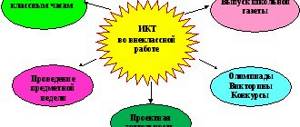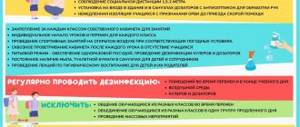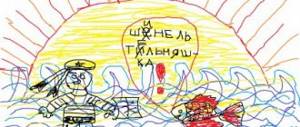Author of the material: Kvakina Tatyana Nikolaevna -
teacher of Russian language and literature MKOU Krasnooktyabrsk secondary school, Chuvashi village, Kirovo-Chepetsk district, Kirov region
Expert: in the field of Russian language, literature, teaching methods, speech therapy
The teacher’s task now, in contrast to previous work, when it was possible to explain, show, tell everything as clearly and as accessible as possible in the lesson, is to include the student himself, even the weakest, in educational activities.
The teacher must organize the lesson so that children independently acquire new knowledge and independently apply this knowledge in solving various problems: cognitive, educational and practical, life.
Reception “Category “For the Curious”
It contains unusual, amazing information about your native language, its history, the origin of many words and expressions, as well as information about the science that studies language.
Example. It is a known fact that V. Hugo, having finished the novel “Les Miserables,” sent the manuscript to the publisher, attaching a letter to it that did not contain a single word. The letter consisted of a "?" The publisher immediately responded with a wordless letter: “!”
The result of effective school motivation is one thing - the sincere interest of students.
Reception “Mini-research” or “Mini-project”
Example Mini-project “Polysemantic words”, which is as follows:
Students must make a flower whose petals are the meanings of a polysemantic word.
When working on this project, children, first of all, work with an explanatory dictionary, with a dictionary entry, that is, they check the correctness of the chosen example.
When completing the mini-project “Phraseological Units”, students complete the following task:
they must illustrate the phraseological unit, remembering its metaphorical and figurative nature.
The complexity of the task and at the same time its interest lies precisely in the fact that the children themselves must come up with a metaphorical image that would reflect all the emotions embedded in the phraseology, and not use ready-made illustrations.
Interactive learning technology in Russian language and literature lessons
“This is a terrible danger - idleness at the desk: idleness for six hours every day, idleness for months and years - it corrupts, morally cripples a person, and neither the school team, nor the workshop, nor the school site - nothing can compensate for what is lost in the most important area where a person must be a hard worker - in the sphere of thought." V. A. Sukhomlinsky
I turned to Sukhomlinsky’s words because I adhere to this point of view, I believe that the main task of a teacher is to teach a student to learn.
In the process of work, the student changes his workplace, he changes seats, goes to the board, works in a small group, speaks, writes, participates in discussions, listens, creates. This helps to activate physiological parameters. After all, movement is life!
Social activity is associated with the fact that during work the student comes into contact, interacts with others, establishes some kind of relationship, exchanges information, shows leadership qualities, asks questions, allows himself to be taught, and comments on something.
And this in turn gives rise to cognitive interest. Students pose questions, look for ways to solve them, find additional information, make amendments, additions, and create projects.
Interactive technologies fit easily into the curriculum without interfering with traditional teaching methods. Motives for behavior change appear. In adolescents, they are associated with the desire to maintain their positions in the group, strengthen them, expand their zone of influence and control the situation. There is a need to constantly adapt your behavior to changing circumstances. And at the same time, participants in the interactive lesson feel the challenge that new tasks and emerging problems pose to their intellect. They learn to create their own life projects, and this requires mental effort.
Interactive technologies awaken the full range of feelings associated with leadership, competition, relationships, and solving educational problems. Children are actively involved in the educational process when internal tension is relieved. And all this contributes to personal growth.
The effectiveness of using interactive teaching methods depends on many factors. First of all, it depends on the willingness of the teacher himself to embark on this path and change his view of the traditional education system. It also depends on the readiness of the class to move to new forms of relationships. Success also depends on the belief that these methods work for educational purposes. It is very important that the teacher has communicative competence and knows how to conduct a dialogue.
“There are only as many good methods as there are good teachers.” D. Polya
“Pedagogical technology is a model of joint pedagogical activity thought out in every detail in the design, organization and conduct of the educational process with the unconditional provision of comfortable conditions for students and teachers.” V. M. Monakhov
Modern pedagogy is focused on ensuring that the child learns to learn, discovers the energy of cognition, and the constant desire to acquire new knowledge.
The success of the learning process depends largely on relationships:
a) teachers with children; b) children with each other; c) each child with a teacher; d) a student with a team.
The idea of cooperation comes from the ancient sages and goes through the philosophy of many spiritual teachings, classical pedagogy and psychology. In pedagogical practice, the term active methods and forms of learning has long been used. It unites a group of pedagogical technologies that achieve a high level of active learning activity among schoolchildren.
Recently, another term has become widespread - interactive learning.
The term interactive learning (English) means learning based on active interaction with the subject of learning (leader, teacher, coach, leader). Essentially, it represents one of the options (models) of communication technologies: their classification parameters coincide. In other words, interactive learning is learning with well-organized feedback from subjects and objects of learning, with a two-way exchange of information between them.
Interactive teaching methods are a system of rules for organizing productive interaction between students and with the teacher in the form of educational, business, role-playing games, discussions, in which new experiences are mastered and new knowledge is acquired.
The use of interactive teaching methods in the classroom allows you to solve the following problems:
- actively involve each student in the process of mastering educational material; increase students' cognitive motivation;
- teach successful communication skills (the ability to listen and hear each other, build a dialogue, ask questions for understanding);
- develop skills of independent learning activity (the ability to identify leading and intermediate tasks, provide for the consequences of one’s choice, and give it an objective assessment);
- develop leadership qualities;
- learn to work with a team and in a team;
- be responsible for joint and own activities to achieve results.
Interactive learning is learning through experience (structure): participants experiencing a specific experience (game, exercise, situation), understanding the experience gained, generalizing it, applying it in practice.
Main features of interactive learning:
- forced activation of cognitive activity;
- independent search for a solution to a problem;
- changing the role of the teacher to that of an organizer or consultant;
- exclusion of monologue presentation of material;
- conversational nature.
The main feature of interactive learning is dialogue learning, during which interaction between teacher and student takes place. In addition, this is a special form of organizing cognitive activity. She has very specific and predictable goals in mind. One of these goals is to create comfortable learning conditions - ones in which the student feels successful, intellectually competent, which makes the learning process itself productive.
The essence of interactive learning is that the learning process takes place in conditions of constant, active interaction of all students. This is based on cooperation and mutual learning: teacher - student, student - student. At the same time, the teacher and the student are equal, equivalent subjects of learning. The educational process is organized in such a way that almost all students are involved in the learning process, they have the opportunity to understand and reflect on what they know and think.
The joint activity of students in the process of learning and mastering educational material means that each participant makes his own contribution, resulting in the exchange of knowledge, ideas, ways of working in an atmosphere of goodwill and mutual support, which allows not only to obtain new knowledge, but also develops the cognitive activity.
Interactivity eliminates the dominance of either one speaker or one opinion over another. During dialogue learning, students learn to think critically, solve complex problems based on analysis of circumstances and relevant information, weigh alternative opinions, make thoughtful decisions, participate in discussions, and communicate with other people.
To do this, in the lessons the teacher organizes (types of work) individual, pair and group work, uses the method of research projects, role-playing games, works with documents and various sources of information, uses creative types of work
There are various forms of interactive learning.
The use of interactive teaching methods allows:
- develop interest in the subject being studied;
- develop student independence;
- enrich the social experience of students by experiencing life situations;
- feel comfortable in class;
- students to express their individuality in the educational process.
The introduction of interactive technologies requires the teacher to understand the essence of the teaching model, the ability to carefully plan their work, and a significant amount of time, especially in the initial stages. Elements of interactive technologies should be introduced progressively in individual lessons, starting with the simplest ones - working in small groups, pairs, trios, using methods such as “brainstorming”, “microphone”, etc.
The teacher should understand:
- the content of such a lesson is program material;
- the goal is the implementation of educational goals, the overall development of students, providing each of them with optimal opportunities for personal development and development, expanding opportunities for self-determination;
- the result is the creation of didactic conditions for the child’s success in the process of educational activities, enrichment of his motivational, intellectual and other spheres.
Classification of interactive technologies
1. Lecture - oral or using modern technical means, presentation, etc. Indispensable when transmitting a relatively large amount of information in a structured form. Lack of feedback.
2. Seminar - collective discussion of a certain problem or topic in various forms. Activation of information perception through interaction between teacher and student. Limitations on duration, number of participants, their preparedness.
3. Imitation game - a model of the living environment that determines the behavior of people and the mechanisms of their actions in extreme situations (“Conflict”, “Shipwreck”, “Robinson”, etc.). Allows you to gain adaptation skills to a new environment. A teacher who does not have communicative competence will not teach new experiences.
4. Business game - a model of interaction between students in the process of achieving goals, simulating the solution of complex problems in a specific situation. Allows you to master a system of skills, abilities, behavior patterns and socio-psychological relationships in a real situation.
5. Role-playing is a method of “playing out” roles (dramatization). One’s own experiences are remembered vividly and persist for a long time. The game contains some risk and brings results only when the group is ready to get involved. It is not always possible to reproduce a real life situation.
6. Situational analysis (analysis of specific situations, case stages, incident, basket method). Provides an opportunity to study complex or emotionally significant issues in a safe environment, and not in real life with its threats, risks, and anxiety about unpleasant consequences in case of a wrong decision. When faced with a real-world problem, a student is unlikely to have the same time, knowledge, and safe laboratory conditions available to deal with it.
7. Heuristic technologies for generating ideas: “brainstorming”, associations (metaphors) In this case, ideas are generated, intuition and imagination are activated, and the boundaries of standard thinking occur. But! Inept leadership on the part of the teacher can lead to avoidance of the real problem, loss of time, poor results, etc.
Algorithm for conducting an interactive lesson
- Motivation - 2 min (5%).
- Statement of the problem - 2 min (5%).
- Background information and briefing – 2 min (5%).
- Practical learning of the material through an interactive task - 24 minutes (60%).
- Summing up, reflection - 10 minutes (15%).
In my lessons I use the following types of interactive methods:
- heuristic technologies for generating ideas (“brainstorming”, method of associations);
- methods for activating the educational process (projects, analysis of specific situations, role-playing games, method of content analysis of a story, modeling of the artistic and creative process, discussions);
- business games and social trainings that teenagers love so much.
Lesson technology:
1. Beginning of the lesson - challenge stage (updating basic knowledge)
- “Brainstorming” (individual, pair, group, frontal)
- Cinquain ("oriental verse")
- Hook (parable, game, “hook”)
- Clusters
- Discussion of creative homework
2. The semantic part is the presentation of new material (independent acquisition of new knowledge, teaching each other) This could be: an unfinished sentence, a humorous story, a fairy tale, a glossary (compiling a dictionary of key words and concepts of the lesson)
3. Reflection - receiving feedback.
When assessing the results of interactive learning, the teacher must consider:
- group work;
- self-esteem of a group work participant;
- freedom of thought;
- mastering cultural forms of work;
- communication in educational dialogue.
At the stage of updating basic knowledge, the teacher conducts the “Microphone” exercise. “Microphone” Students are invited to express their point of view on the question or problem posed. The teacher throws an object simulating a microphone around the class. Everyone who receives such a microphone is obliged to clearly and concisely express their thoughts and draw a conclusion.
At the stage of cognitive activity it is possible to use:
- “Teaching - learning” The teacher divides the lesson material into separate blocks according to the number of students in the class. Students practice and exchange information, creating temporary pairs, after which there is a collective discussion and consolidation of the educational material.
- “Carousel” Students are placed in two circles facing each other. For some time, each couple exchanges information and their thoughts; After this, students in the outer circle move around the circle to the next partner. You can first invite students to prepare questions on the topic and conduct a survey in a circle.
- “Two, four - together” Students are presented with a problem or information, which they first work out independently, then discuss in pairs, and then unite in groups of 4 people. After making a joint decision, the groups discuss the question and present an answer.
- “Synthesis of ideas” This exercise involves groups performing all types of lesson tasks step by step: on separate sheets of paper, the 1st group completes the first task, the 2nd - the second, etc. After completing the tasks, the 1st group gives their sheet for revision 2 group, the second to the third, etc. When the revised piece of paper is returned to the “owners,” each group presents its research, taking into account the additions of its classmates. Before starting work, you can create a separate expert group that will evaluate the productivity of all groups.
- “Brainstorming” To solve a problematic issue, students are asked to find as many ways, ideas, proposals as possible, each of which is recorded on a board or piece of paper. After creating such a “Bank of Ideas,” analysis and discussion are carried out.
If we launch the mechanism of cognition, if the child enjoys both new knowledge and communication, then over time the mechanism will be fine-tuned and improved, and, becoming an adult, a person will say, following Pushkin: “At the beginning of my life, I remember school...”. A school where I didn’t go through subjects, but where I was, lived, studied and comprehended...
Motivation is the main condition for interactive learning.
Thus, the main goal of my methodological system is realized: creating conditions for the formation of a student motivated for active cognitive learning activities; development of his cognitive and creative abilities, ensuring creative self-realization; formation of experience of independent activity.
LITERATURE:
- RUSSIAN LANGUAGE AND LITERATURE. EVERYTHING FOR THE TEACHER! 3 No. 2 (62) February 2016
- [Electronic resource]. — Access mode: https://www.lcl.srcc.msu.ru/library/Rafaeva_13_2007_ 1.pdf. — https://human.snauka.ru/2011/10/104 https://www.e-osnova.ru/PDF/osnova_4_62_14111.pdf https://lit-helper.com


